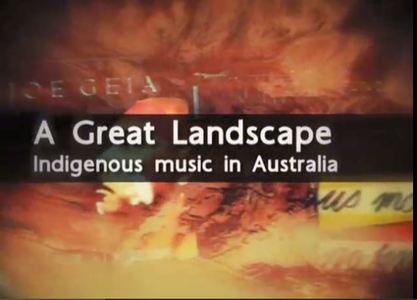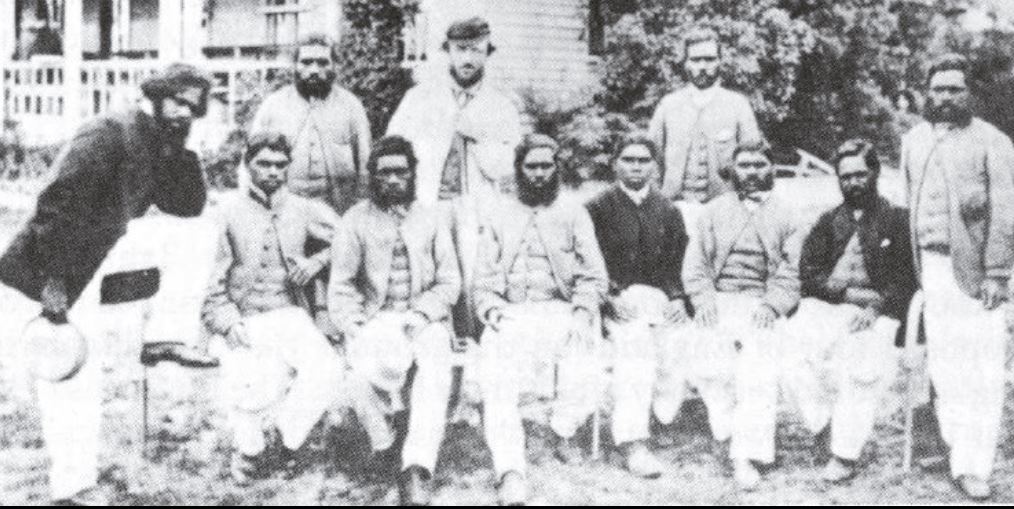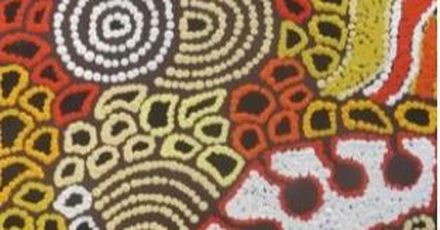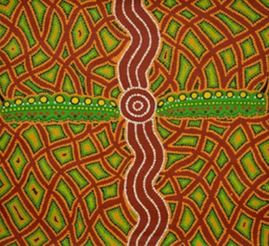Australia Indigenous Religion
A key aspect of Australian aboriginal belief is the Dreaming. At the heart of this is the belief in powerful beings who arose out of the land, created or gave birth to people, plant life and animal life, and connected particular groups of people with particular regions and languages. The Dreaming beings continue to control the natural world, but their willingness to release the powers of fertility depends upon people continuing to perform certain rituals.
People are believed to possess spirits which originate from the dreaming. As children grow up they undergo a variety of rites of passage which initiate them into adulthood. Boys would be subjected to practices such as, circumcision, subincision into the urethra, blood letting or tooth pulling. Girls would be ritually decorated, and subject to partial seclusion or food taboos. Totemism was also important to the aboriginal world view. The representation of mythic or living beings was seen to provide the means to access the spiritual powers of the Dreaming. History Aborigines first arrived in Australia about 40,000 years ago at a time when there was a land bridge between Asia and Australia. Overtime much of the continent came to be occupied and cut off from Asia as a result of rising sea levels. Between 3,000-4,000 years ago the Aborigines began to use various stone tools. Over the past 2000 years the population grew significantly and adapted itself to the various environmental and climatic conditions of the continent. By the time the first Europeans settled in Australia in 1788 there were perhaps as many as a million aborigines in Australia and over 200 different spoken languages. Prior to the arrival of the Europeans the only known outside encroachment into Australia was by Indonesian Muslims, the Macassans, who fished off Arnhem Land in the northern territory and who are the subjects of a number of aboriginal myths. While the impact of the Macassans on the aboriginal population was limited, the impact of the Europeans was huge. The presence of Europeans had a devastating effect on the indigenous population. By 1850 96 per cent of the indigenous people of south-easteran Australia had been wiped out through disease, enforced labour or outright murder. This situation inspired the emergence of a number of millennial cults which anticipated the destruction or repatriation of white settlers. Among the best known of these was the Mulunga, a ceremony designed to use supernatural powers to undermine the power of whites. The Songlines an extract from Bruce Chatwin's book of the same title. It is a story from central Australia
|

The Missions
Europeans brought with them Christian missionaries. In 1821 the Wesleyan Missionary Society established the first missionary presence among the aborigines. From this basis the missionary presence spread throughout the whole continent so that by the middle of the 19th century there were church settlements virtually throughout Australia. In spite of some resistance to missionary teaching, evangelical Christianity was widely accepted among the aborigines. Today over two thirds of Australian aborigines would identify themselves as Christian. Stolen Generations Between 1910-1970, many Indigenous children were forcibly removed from their families as a result of various government policies. The generations of children removed under these policies became known as the Stolen Generations. The policies of child removal left a legacy of trauma and loss that continues to affect Indigenous communities, families and individuals. The forcible removal of Indigenous children from their families was part of the policy of Assimilation. Assimilation was based on the assumption of black inferiority and white superiority, which proposed that Indigenous people should be allowed to “die out” through a process of natural elimination, or, where possible, should be assimilated into the white community Symbols There is considerable variety in the art forms to be found in traditional Australian aboriginal religion. The oldest remaining art forms are engravings on cave walls of animals or people. In New South Wales large sculptures engraved in trees have been found. Smaller artefacts such as baskets, shields, boomerangs contain various abstract forms or animals such as snakes and fish. Aboriginal communities were to be found throughout the whole of Australia. http://aiatsis.gov.au/explore/articles/aboriginal-australia-map The Australian Institute of Aboriginal and Torres Strait Islander Studies (AIATSIS) is the national research and collecting institution for information and research about the cultures and lifestyles of Aboriginal and Torres Strait Islander peoples, past and present. You can visit this website here - http://www.aiatsis.gov.au/main.html | ||||||||||||||||
Ongoing Contribution of Indigenous Australians
Indigenous MusicThis program looks at the many diverse new forms of music and the trail-blazers who paved the way for the new and diverse contemporary Aboriginal sounds. It looks at the early beginnings of choir and Country, to Hip Hop, Funk and Rap. It provides a broad coverage of just how many musicians are part of Australia's Indigenous musical entourage. It looks at how their stories and music are broadcast to the nation via new technologies such as National radio, MySpace, Facebook, and downloadable MP3 files
Indigenous Community LeadersIndigenous Sporting HeroesIndigineous Art |
Took The Children Away
Archie Roach This story's right, this story's true I would not tell lies to you Like the promises they did not keep And how they fenced us in like sheep. Said to us come take our hand Sent us off to mission land. Taught us to read, to write and pray Then they took the children away, Took the children away, The children away. Snatched from their mother's breast Said this is for the best Took them away. The welfare and the policeman Said you've got to understand We'll give them what you can't give Teach them how to really live. Teach them how to live they said Humiliated them instead Taught them that and taught them this And others taught them prejudice. You took the children away The children away Breaking their mothers heart Tearing us all apart Took them away One dark day on Framingham Come and didn't give a damn My mother cried go get their dad He came running, fighting mad Mother's tears were falling down Dad shaped up and stood his ground. He said 'You touch my kids and you fight me' And they took us from our family. Took us away They took us away Snatched from our mother's breast Said this was for the best Took us away. Told us what to do and say Told us all the white man's ways Then they split us up again And gave us gifts to ease the pain Sent us off to foster homes As we grew up we felt alone Cause we were acting white Yet feeling black One sweet day all the children came back The children come back The children come back Back where their hearts grow strong Back where they all belong The children came back Said the children come back The children come back Back where they understand Back to their mother's land The children come back Back to their mother Back to their father Back to their sister Back to their brother Back to their people Back to their land All the children come back The children come back The children come back Yes I came back. Songwriters: Archibald William Roach Took The Children Away lyrics © O/B/O Apra Amcos |
Welcome to Wudawurrong Country
|
One that might make a better followup to the talk by a local tribal person
|
|
| ||||||||||||
Aboriginal Ritual (Land, Fire and Water Ceremony)
|
Aboriginal Spirituality
Until recently the discussion of Aboriginal people and religion often revolved around whether Aborigines were responding to overtures from Christian missionaries or maintaining their own spiritual identity. The question of syncretism might also be raised, generally with disapproval on the Christian side, where this would often be seen as dilution of Christian beliefs. It is only in the last twenty or so years that the potential contribution of Aboriginal people to the spiritual life of Australians of all backgrounds has been seriously considered. This has often emerged in consideration of the ecological issues relating to care of the land, and the special part that the land has played in Aboriginal spirituality. Many non-Aborigines have become familiar with the fire ceremony of cleansing, which is sometimes incorporated into Christian ritual. There is of course much room for debate on the possibility of validly incorporating aspects of ritual or belief from one belief system into another. Both Christians of Western background and Aborigines might have questions on the suitability of some adaptations if these are not done with sufficient care, understanding and sensitivity to the issues involved. Whatever the outcome in specific cases, it is clear that when looking at the religious experience of Australians in their culture, the Aboriginal contribution will play a significant role, for Aboriginal people themselves and for Australian society as a whole. The experiences of Aboriginal Christians will also be important. |
GLOSSARY
Syncretism is the combining of different, often seemingly contradictory beliefs, while melding practices of various schools of thought. Assimilation Assimilation policies presumed that Indigenous Australians could enjoy the same standard of living as white Australians if they adopted European customs and beliefs and were absorbed into white society |
|
Land, Fire and Water Ceremony A container of local earth, a container of water (usually a coolamon) and a fire are placed at the front of the assembly. The room (if possible) is in darkness with just enough light for the following to be read. If possible the didgeridoo should be heard in the background. The ceremony can take place with Indigenous people alone or with Indigenous and Non-indigenous. This version presumes the presence of Non-indigenous people and has a Reconciliation theme. The ceremony can be adapted for use with Indigenous people alone. The text for the ceremony can be viewed here
| |||||||







